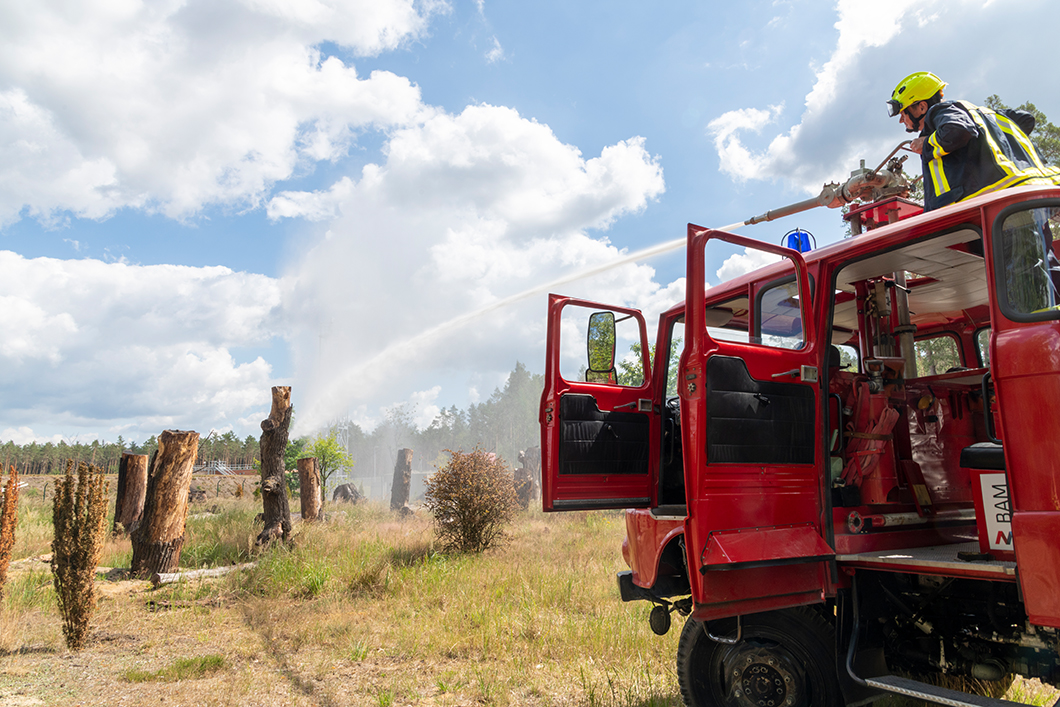
Fires must be prevented by proactive measures. The picture was taken during a forest fire exercise at BAM's Technical Safety Test Site (TTS) in Horstwalde, 60 km south of Berlin.
Source: BAM
Project period
01/12/2021 - 30/05/2025
Project type
EU project
Project status
Ongoing
Description
46 institutions from Europe and Taiwan have joined forces to develop a holistic brand management system.
Location
Bundesanstalt für Materialforschung und -prüfung
Unter den Eichen 87
12205 Berlin
Forest fires are increasingly becoming a threat to the climate. BAM is conducting research in a major European project to prevent and contain the fires. Source: Adobe Stock/JAH
Forest fires have increased significantly worldwide in recent years. Scientists assume that climate change will drastically increase the risk of such environmental disasters. This is because periods of heat and drought are also increasing as global warming progresses - they are ideal catalysts for fires. Together with 45 other scientific institutions from all over Europe, BAM is conducting research on a new, holistic fire management system to prevent forest fires that have a damaging effect on climate change.
Source: BAM
Source: BAM
The fire management system is to incorporate data from around 40 satellites of the European atmospheric monitoring service Copernicus. They will be made available to the project by the European Space Agency (ESA). The system will also include simulations developed with artificial intelligence and machine learning, drones for real-time monitoring of forests and virtual reality in the training of emergency forces. An integrated risk assessment system is also planned.
Source: BAM
Coordination
RISE Fire Research, Norwegen
BAM sub-project
BAM Division Technical Properties of Polymeric Materials
BAM Section eScience
Consortium
46 scientific institutions form Europe and Taiwan
Funding
European Union’s Horizon 2020 research and innovation programme
A Holistic Fire Management Ecosystem for Prevention, Detection and Restoration of Environmental Disasters
Together with 45 other scientific institutions from all over Europe, BAM is conducting research on a new, holistic fire management system to prevent forest fires that have a damaging effect on climate change. The large-scale project, which is scheduled to last 3.5 years, is funded by the EU's Horizon 2020 programme with 23 million euros.
The fire management system is to incorporate data from around 40 satellites of the European atmospheric monitoring service Copernicus. They will be made available to the project by the European Space Agency (ESA).
The system will also include simulations developed with artificial intelligence and machine learning to predict the spread of fires, drones for real-time monitoring of forests, and virtual reality for training emergency services. An integrated risk assessment system is also planned, with which fires can be effectively fought or, if possible, prevented altogether.
The fire management system will initially be implemented in eight of the participating countries.
BAM's contribution
In Germany, the case study is taking place under the direction of BAM, which has many years of experience in the experimental investigation of fires and their spread.
Soil samples from Brandenburg and Saxony-Anhalt, regions that have been particularly affected by forest fires in Germany in recent years, will also be specifically examined for their role in fire spread. For this purpose, parameters such as density, pH value and the special structure of the organic material in the forest soil are being examined more closely. The findings are crucial for understanding how forest fires spread, but also for assessing the effectiveness of extinguishing measures and the choice of suitable extinguishing agents.
Globally, forest fires have increased significanty in recent years. Scientists assume that climate change will drastically increase the risk of such environmental disasters. This is because periods of heat and drought also increase as global warming progresses - they are ideal catalysts for fires. In addition, fires are now raging longer and more intensely due to climate change.
Global climate change is not only triggering more and more forest fires, it is also ensuring that forest fires themselves are a growing threat to the climate: The flames release large amounts of CO2 and climate-damaging substances such as methane and soot, and they destroy large areas of forest that would be significant in slowing climate change.
It is therefore all the more important to prevent fires by taking preventive measures and, where this is not possible, to detect sources of fire early and fight them quickly. The new fire management system of the research association, in which BAM is involved, would bring us much closer to these goals.
Coordination
The overall coordination of the project lies with RISE Fire Research, Norway.
Coordinator: Kemal S. Arsava
BAM sub-project
Bundesanstalt für Materialforschung und -prüfung (BAM)
Division Technical Properties of Polymeric Materials
Dr.-Ing. Anja Hofmann-Böllinghaus
Section eScience, Dr. rer. nat. Philipp Benner
Consortium
47 scientific institutions form Europe and Taiwan
Funding
This project has received funding from the European Union’s Horizon 2020 research and innovation programme under grant agreement No. 101036926.

Source: DRYADS | Horizon 2020


